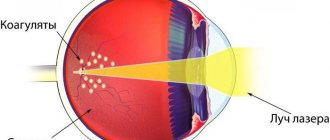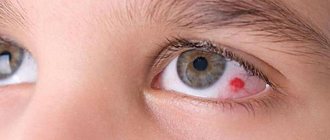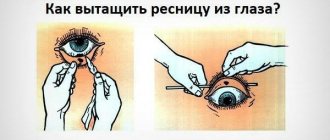Often after childbirth, mothers discover strabismus in children, the causes and treatment of which E. Komarovsky recommends identifying and prescribing only after the first 4-6 months of life. Strabismus in newborns is a normal physiological phenomenon; in the first months of life it should not cause alarm. But if the child’s eyes continue to work inconsistently, the strabismus must be treated - and the sooner the better.
Why do newborns cross their eyes?
When a newborn's eyes wander in different directions, it can alarm even an experienced mother. Strabismus in infants can be of two types:
- Functional. This condition is not a pathology. During intrauterine development, the child had no need to focus his gaze, so his eyeball muscles are not trained. The centers of the brain that control eye movement reach a level of sufficient development by 3-4 months. Until this age, the pupils of infants act uncoordinated and can move horizontally, only mastering vertical movement. The skull of newborns has a peculiarity: its right and left halves form an angle, so from the outside it seems that it is squinting. Functional strabismus disappears by the first six months of life.
- Persistent strabismus - strabismus, heterotropia. The visual axes of both eyes are unable to connect to one point, and the eyes always look in different directions. If a baby has this pathology from birth, it is in vain to expect that strabismus will go away by 4-6 months of life. Persistent strabismus occurs in 2% of newborns; it is due to the following reasons:
- oxygen starvation of the fetus during pregnancy and childbirth leads to disruption of the visual centers of the brain;
- infectious diseases of the mother, especially in the first trimester of pregnancy;
- complications after infections suffered by the newborn itself;
- congenital brain diseases (cerebral palsy, Down's disease, etc.);
- severe fear, other mental or physical trauma;
- hereditary factor.
Authoritative pediatrician E. Komarovsky warns: if after 6 months the child’s strabismus does not go away, he must be taken to an ophthalmologist.
Advanced strabismus complicates the process of developing binocular vision; the baby’s brain will form compensatory reflexes, the strengthening of which will complicate treatment. A decrease in visual acuity is inevitable.
Strabismus in children under one year of age can be recognized by the following signs:
- The baby's gaze cannot concentrate on one point.
- No synchronous eye movement.
- In bright light, one eye closes or moves to the side.
- The baby turns his head to see the object with one eye.
- The child bumps into surrounding objects, because... Poorly assesses spatial depth.
Clinical manifestations
Parents may suspect strabismus in children under one year of age on their own. If there is an asymmetrical arrangement of the pupils and iris in relation to the palpebral fissure (after 6 months), it is worth consulting an ophthalmologist. Suspicious symptoms include:
- a peculiarity in holding his head - the dear child tilts his head to one side or another when he tries to see something;
- squinting – the baby squints the organ of vision involved in the pathological process, looking at the toy;
- frequent rubbing of the eyeballs - caused by rapid fatigue and tension when looking at something;
- a veil before the eyes (can be detected in older children);
- headache - caused by tension in the visual organs and their fatigue;
- lack of depth vision - objects are perceived flatly, while trying to walk the child bumps into objects;
- inability (pain) to perceive light;
- doubling of objects, their vagueness;
- lack of simultaneous movement of the organs of vision;
- inability to direct both eyeballs to an object/picture;
- different reflection – when you try to shine light into a child’s eyes, different reflections are observed in the pupils.
If the eye/eyes deviate towards the temples, then a decrease in visual acuity occurs as a type of myopia. If the visual organs deviate towards the bridge of the nose, farsightedness occurs.
Paralytic heterotropism is accompanied by immobility or limited mobility of the squinting eye. In addition, with this type of pathology, a dilated pupil, ptosis (drooping of the upper eyelid) and paralysis of accommodation are observed. These symptoms indicate damage to the optic nerve.
What not to do with barley
Neglect of hygiene rules or incorrect actions can lead to complications of stye.
If you have barley, you should not:
Squeeze out the abscess.
The procedure for cleansing barley from pus can only be carried out by a medical professional. Self-squeezing often leads to the spread of infection to healthy tissue.
Touch the barley with your hands.
During illness, it is important to ensure that the child does not touch the inflamed area with his hands. This can be achieved by regularly wiping the eye area to remove skin particles and dust, which most often cause irritation.
The child's hands should always be clean; you can use antibacterial soap or gel to wash them.
Use dirty tools.
Before each use, the pipette and the tip of the eye drop bottle should be cleaned with alcohol. Cotton swabs, swabs and pads should be changed regularly, using fresh ones for each area.
Use sharp tools.
Children are unable to seriously assess a situation and concentrate. Therefore, during treatment you need to use pipettes with a rounded end, and be extremely careful.
Before using the drug, you should carefully read the instructions.
It is important to pay attention to expiration dates and individual contraindications.
Causes and types of strabismus
True strabismus is not always a congenital pathology. During the first 3 years, when binocular (3D) vision is actively developing, the following reasons lead to the appearance of an asymmetrical gaze:
- congenital farsightedness or myopia - the difference in refraction between the right and left eyes;
- diseases of the central nervous system: cerebral palsy, brain tumor, etc.;
- severe stress: bruise, fright, vaccination, acute respiratory viral infection or other viral disease.
Normal operation of both eyes produces two images; the visual analyzer combines them into one and forms a three-dimensional image. With strabismus, the images fail to connect and the brain ignores what the squinting eye sees. His visual acuity gradually decreases, lazy eye syndrome may develop, he stops moving and perceiving objects. The child develops a flat image of the world. Established pathology is difficult to correct, so it is important to start treatment on time.
If there are cases of hereditary strabismus in the family, parents should regularly check the child's vision in the first three years.
Dr. Komarovsky emphasizes that in the period up to 3 years, any injury can provoke heterotropia, and at this time, hidden strabismus, invisible in a newborn, progresses. Therefore, visits to the ophthalmologist should be mandatory at 2, 6, 12
months, and then once a year until school age.
In total, there are about 25 types of strabismus, the formation mechanism of each of them is different, and, therefore, the treatment methods are different. Based on the displacement of the visual axes, 4 types of strabismus are distinguished.
- esotropia - convergent strabismus, when the eyes converge on the bridge of the nose, this deviation occurs with congenital farsightedness;
- exotropia - divergent position of the eyes, when the ocular axes are shifted towards the temples, this type is characteristic of myopia;
- vertical heterotropia - displacement of the visual axis up or down.
Types of strabismus
Before finding out the intricacies of modern methods for correcting strabismus in children, it makes sense to figure out what kind of ailment it is. So, strabismus (otherwise known as strabismus or heterotropia) is any violation of the visual axes of both eyes, which normally should be parallel. The most obvious and obvious symptom of strabismus is an asymmetrical gaze.
In medicine, the following types of strabismus are distinguished:
- Horizontal strabismus.
This is the most common type of strabismus. It can be converging (esotropia - when the eyes “slid” towards the bridge of the nose) or divergent (exotropia - when the eyes “gravitate” outwards, towards the outer corner). - Vertical strabismus.
Moreover, deviations can be both upward - hypertropia, and downwards - hypotropia).
In addition, strabismus is conventionally divided into monocular
and
alternating
. In the first case, only one eye is always squinting, which the child practically does not use, which is why the vision of the squinting eye gradually decreases and dysbinocular amblyopia develops.
Alternating strabismus is distinguished by the fact that both eyes alternately squint (first one, then the other). And since both eyes (albeit periodically) are used, the deterioration of visual function, as a rule, occurs to a much milder extent than with monocular strabismus.
Prevention of astigmatism
Prevention will not help a person with congenital astigmatism; the processes cannot be stopped. It is important to constantly be under the supervision of a doctor and monitor the condition of your eyes. He will prescribe appropriate treatment. If we talk about an acquired disease in children, then it can be avoided. To do this, certain rules must be followed:
- Taking vitamin complexes.
- Reduce children's prolonged exposure to computers.
- Prepare for lessons in good lighting.
- Lead a healthy lifestyle, play sports, preferably swimming.
Prevention
The following rules will help prevent strabismus in newborns:
- Lack of small toys and objects;
- Place toys at a distance of at least arm's length;
- The placement of the rattles is central on the wall, the baby should see them with both eyes at the same time.
An unexpected approach to a baby with bright objects in his hands is not recommended; this can also lead to the development of strabismus. Prevention will not help get rid of strabismus one hundred percent; the problem only gets worse with age.
In adulthood, only surgical intervention will help solve the problem.
Development of the disease
There are two different mechanisms for the development of strabismus.
- A concomitant form of strabismus, when refraction (refraction of rays) is impaired in one or both eyes. It is hereditary and manifests itself in childhood. It is treated with glasses and lenses if accommodation – vision focusing – is impaired. If there is organic damage to the optical media, corneal surgery or lens replacement is necessary.
- Paralytic form. The work of the eye deviates from normal fixation due to paresis of one or more muscles. Eye movement is limited to one direction; a glance in this direction is accompanied by a characteristic turn of the head. Paralysis of the eye muscles is most often an acquired pathology (trauma, severe stress, brain damage). Restoring normal eye movement function occurs through physical therapy and subsequent surgery to correct the paralyzed muscle.
As you can see, different forms of strabismus require their own treatment methods.
Dr. Komarovsky warns that self-treatment of strabismus with folk remedies can be harmful if the mechanism of its occurrence is unknown. Only an ophthalmologist can make an accurate diagnosis and prescribe adequate treatment.
Treatment
Why children are born with strabismus, whether it needs to be treated and how to do it is determined by a pediatric ophthalmologist. The physiological form goes away on its own by 4–6 months and does not require any treatment. To treat other types, various methods are used. When strabismus goes away is an individual question. It depends on the characteristics of the body and the speed of development of the baby.
Komarovsky's opinion
The famous children's doctor Oleg Komarovsky does not consider strabismus in newborns to be a serious pathology. He points out that in the vast majority of children, strabismus disappears by the age of four months. If the signs remain, timely examination by an ophthalmologist and proper treatment can get rid of the problem without any consequences.
In his opinion, how long strabismus will last cannot be predicted in advance. All doctors indicate the average time for vision restoration to be within 3–6 months.
Watch the pediatrician's video explanation:
Exercises
The main method of treating strabismus in newborns and infants is gymnastics. There are several options for exercises that are selected according to the age of the child:
- a bright toy is moved in front of the newborn’s face, at a distance of 40 cm, from side to side, trying to get him to follow it;
- bring the toy closer to the newborn’s face, then move away;
- sit the child on a chair, turn on the lamp, close one eye and invite the baby to look at the lamp with the other for a few seconds.
Exercises are done for at least two hours during the day, distributed over several approaches.
Surgery
The operation is carried out according to strict indications. When paralytic strabismus is detected in a newborn, there is no effect of conservative therapy. The intervention consists of plastic surgery of the eye muscles - their shortening or lengthening as necessary.
After the operation, the newborn is instilled with antibacterial and anti-inflammatory drops and healing agents. The operation eliminates only a cosmetic defect, but does not restore vision. Therefore, the child must be prescribed glasses.
Other methods
In addition to exercises, a child with strabismus needs vision correction with glasses. They are prescribed to be worn from 8–12 months. Glasses are prescribed taking into account the type of visual impairment - astigmatism, farsightedness or myopia.
Modern methods of treating strabismus
The concomitant type of strabismus is treated for 2-3 years. The image on the retina is corrected using lenses and special glasses. Occlusion is used to correct low vision in the squinting eye (amblyopia). The healthy eye is switched off from the act of vision (atropine and special stickers on the eye - occluders are used for this). In this regard, Komarovsky advises sending a child with strabismus to specialized kindergartens, where all children are treated using this method, and there is no discomfort in communication. We list other treatment methods:
The unfriendly (paralytic) type of strabismus is treated in 2 stages:
- Conservative treatment: gymnastics of the eye muscles; exercises to eliminate duality; physiotherapy (electrophoresis, reflexology, etc.).
- Surgery consists of shortening or weakening the eye muscle that deviates the eye from proper fixation. It is carried out using computer modeling using high-frequency radio wave technology.
A successful result in the treatment of strabismus is possible with timely seeking help from a specialist, with sufficient patience and persistence in following all the recommendations of the ophthalmologist.
What treatment is expected?
Treatment of strabismus in children is carried out only after a thorough examination and identification of the causes that provoked the pathology. Using special equipment and tables, the ophthalmologist will check the angle of the child’s strabismus, examine eye mobility in different directions, evaluate the joint work of the eyes, and, if necessary, recommend consultation with a neurologist.
Treatment of this disease in children should be carried out in a timely manner, since it is quite long and can take about 2-3 years. The result in this case will depend on careful compliance with all the doctor’s recommendations. The course of treatment requires constant examination and correction.
Among the main treatment methods it should be noted:
- occlusion, which involves wearing a shutter (occluder) on the healthy eye in order to stimulate vision in the weak eye;
- special gymnastics for weak eyes;
- orthoptic treatment using special ophthalmological devices, which influence the center of the brain responsible for vision and combining two images into one;
- diploptic therapy using photalmological equipment, which consolidates the positive dynamics of ortopic treatment and restores binocular and stereoscopic vision;
- computer treatment using programs aimed at teaching the weak eye to focus correctly on the image;
- surgical intervention is indicated in the absence of positive dynamics as a result of treatment with other methods and is carried out no earlier than when the child is 3 years old.
What exercises can help?
Special eye exercises can be done daily at home. It is best to do this during the day, when the child is not too tired. They can be performed in several steps for 20 minutes. The total daily duration can be 1-2 hours.
The main exercises are:
- approaching the distant index finger along the middle axis or from bottom to top to the nose, closely following it with the gaze;
- describing figure eights with the eyes, performing circular movements, lowering and raising the eyes up and down, as well as moving left and right;
- outdoor games with a ball, shuttlecock or tennis ball;
- shifting the gaze from distant objects to close ones, etc.
These activities can also be used as prevention. They can be performed systematically and regularly.
Loading…
Diagnostics
Diagnosis of pathology is carried out by an ophthalmologist or ophthalmologist. The further treatment plan depends on its results. To identify astigmatism in an infant, the doctor uses skiascopy, which is popularly called the “dark room test.” This method is based on the shadow that appears on the retina from a mirror used by a physician. Having established the type of refraction, the specialist uses a special skiascopic ruler, the basis of which is cylindrical lenses. Using it, he determines the degree of refraction thanks to a lens that can eliminate the shadow that appears on the pupil.
Starting from 3 years of age, the child may be prescribed the following tests:
- Visometry, that is, inspection using tables. It is carried out without correction, followed by fitting of cylindrical lenses in the frame.
- Ophthalmoscopy - examines the fundus of the eye.
- Keratometry. A method that allows you to measure the curvature of the cornea and determine keratoconus and keratoglobus. A computer program is used that calculates the refraction of light along the main meridians.
- Computer refractometry. Using a refractometer, the doctor is able to determine the type and degree of development of astigmatism.
- Slit lamp examination. Involves examining the eyes under magnification.
Sometimes a specialist prescribes an ultrasound of the eye. This is necessary to exclude the possibility of retinal detachment, hemorrhage, and scarring.
Treatment
Optical correction
- Sidorenko vacuum glasses;
- glasses with prismatic lenses;
- innovative glasses with red and blue filters;
- glasses using Fresnel prisms.
Fresnel prisms should only be attached to glasses by an ophthalmologist; you should not do this yourself.
Pleoptics
- electrical stimulation (to improve metabolic processes);
- laser stimulation (to stimulate the retina);
- magnetic stimulation (to improve blood circulation in the organs of vision);
- light-color stimulation (stimulation of the eyes with light flux).
Folk remedies
- Boiling water is poured into a glass.
- Next, 10 g of plant root is added to it.
- The mixture is infused for half an hour.
- The resulting product is filtered.
- Take the decoction four times a day, a quarter glass, 30 minutes before meals.
- A handful of pine needles are poured with 200 ml of boiling water.
- The product is infused for an hour and filtered.
- The finished product is taken in the amount of one tablespoon 15 minutes before breakfast. The course of therapy with its help is not limited in time.
- Boil a liter of water.
- Pour one hundred grams of plant fruits into boiling water.
- Cook the drug for 15 minutes over low heat.
- The broth should be allowed to brew for five hours.
- You can drink this tea several times a day 30 minutes before meals.
Strabismus in newborns
If strabismus is detected in newborns - when does it go away, how to treat it? Such questions are often asked by parents whose children were born with strabismus. As a rule, mothers begin to sound the alarm, but in fact, this defect is easy to correct after birth. Moreover, most often strabismus goes away on its own. But it is still necessary to show the baby to an ophthalmologist, as complications may arise in the form of other ophthalmological diseases.
The main causes of strabismus in newborns
When a person is inside the womb, his body adapts precisely to such conditions. But when a child is born, he needs a new adaptation, this time to our world. It is difficult for any organ to immediately adjust, and even more so for the eyes. The eye muscles are not yet fully formed and do not have the necessary strength. Therefore, in the first days of life, the eyes squint a little. However, there are other causes of strabismus in newborns:
- Complicated childbirth and pregnancy. The fact is that the entire system of the longitudinal brain fasciculus, located behind, is responsible for the synchronous functionality of the eyeballs. If during pregnancy there is hypoxia of the unborn child, weakened microcirculation or other pathological disorders, then microscopic hemorrhage occurs, which disrupts the synchronous functioning of the eyes. If the baby was born for this reason, then parents should prepare for surgery. Because this type of pathology does not respond to conservative treatment methods.
- Another reason is infection of the mother during pregnancy. These can be such simple diseases as acute respiratory viral infections, influenza, acute respiratory infections, measles, scarlet fever, diphtheria, etc.
- A stressful situation for an infant also leads to the development of strabismus. But the disease is most often temporary and manifests itself only during crying or hysteria.
- Presence of ophthalmological pathologies.
- Cerebral palsy, hydrocephalus.
- Infectious diseases - ARVI, influenza, measles, scarlet fever, rubella, diphtheria.
- Injury to the visual organ.
- Genetic predisposition.
Types of strabismus in an infant
IMPORTANT! When will strabismus in a newborn go away? This is probably the most important and worrying question for parents. In fact, strabismus is considered normal up to six months. If it does not go away during this period, then it is important to conduct a more thorough examination of the visual organs by an ophthalmologist.
The main types of strabismus in infants include the following:
- Depending on the time of development, the pathology can be congenital or acquired.
- Stability of manifestation: constant and periodic appearance.
- Degree of involvement: intermittent, unilateral and monolateral.
- Type of deviation: vertical and horizontal. The vertical type of strabismus is characterized by an upward or downward displacement. The horizontal type can be converging (the eyes are shifted towards the bridge of the nose), divergent (the eyes are turned towards the temples) and mixed.
- Development mechanism: accommodative, non-accommodative and partially accommodative.
What to do?
When parents discover strabismus in their newborns, they should immediately contact an ophthalmologist. Next, it is important to visit this specialist every two months. And only after reaching 6 months will the doctor be able to accurately diagnose and identify the type of disease. For six months, parents must independently stimulate the functioning of the eye muscle system. To do this, you need to give your baby only bright and large toys. It is very important to hang rattles above the generally accepted height so that visual concentration is correct. It is advisable to do gymnastics with your newborn every day. These can be simple but effective exercises. The child needs to be in a reclining position. Mom should pick up a bright toy and move it from one side to the other. At the same time, the baby will follow the movement of the object and exercise his eyes, which leads to strengthening of the eye muscles. Then the toy must be moved up and down. If the baby does not respond to the object, then take a toy with sound.
Strabismus in newborns: when does it go away?
Immediately after birth, the baby's eyes cannot fixate the gaze, but the first fixation is noted after a week of life. But it is also short-lived, so at this age it is almost impossible to make an accurate diagnosis. If only the slanting is very pronounced. The child begins to steadily fix his gaze with both eyes at the same time only after a month or a month and a half. But by six months he should be able to distinguish objects and fix his gaze on them synchronously. That is why this age is considered the maximum for making an accurate diagnosis.
When strabismus in newborns goes away - Komarovsky, as an experienced pediatrician, largely agrees with the opinion of his colleagues. Because this physiological feature is characteristic of infants due to the unformed muscular system of the eyes. The point is also that in the first month and a half, babies can only see in the horizontal direction. And only after that vertical vision develops. If this does not happen, then binocular vision is impaired. Therefore, Komarovsky believes that up to six months it is necessary to be especially attentive to the reactions of the child’s eyes.
Rules for the treatment of strabismus in newborns
There is no point in treating strabismus in newborns up to six months. But it is important to carry out certain manipulations during this period. Firstly, it is necessary to create conditions for the normal development of the visual apparatus. This involves good lighting in the room, placing toys at a certain distance and allowing the child to play with large toys. If the baby has other ophthalmological abnormalities, they must be treated in a timely manner. Since strabismus can occur against the background of a stressful situation, parents should avoid them. Namely, you cannot make sharp and excessively loud sounds, appear in front of the child suddenly, and so on. In a word, fear must not be allowed.
Is this normal?
Strabismus in newborns and infants is a natural physiological condition caused by weakness of the eye muscles, as well as the entire body as a whole. After birth, the baby has to learn a lot, for example, coordination of his movements, body control, speech, as well as eye “motility”.
In the process of development, the baby learns to see and focus his gaze, for which it is necessary to master the art of synchronous eye movement. This occurs when the visual muscles are strengthened. That is why by the age of 2–4 months (in rare cases by 6), physiological strabismus goes away on its own.
The so-called posterior longitudinal fasciculus system is responsible for the synchronization of eye movements in infants and vision in general. If the pregnancy proceeded with complications or disturbances (for example, fetal hypoxia), if the baby was injured during childbirth, some nerve centers may be damaged, which is accompanied by microscopic hemorrhages.
In these cases, the child may be born with persistent strabismus of various types:
- divergent, when the eyes seem to move apart towards the temples;
- converging - the eyes shift to the center, to the bridge of the nose;
- vertical - the eyes can be directed both up and down.
Congenital strabismus is a pathology and requires constant monitoring by an ophthalmologist and neurologist in order to carry out timely correction
It is important to remember that if measures were not taken on time, this may negatively affect the baby’s vision.
When to see a doctor?
If strabismus in newborns is temporary and periodic, then you should consult a doctor only if the problem persists until six months of age.
Up to 3–4 (maximum 6) months, the baby’s eyes should learn to move equally and synchronously; if this does not happen, the child must be shown to an ophthalmologist who will select the correct techniques to correct the defect. In some cases, consultation with a neurologist may be required.
In addition, contacting specialists will be necessary if the baby has persistent congenital strabismus, when the incorrect position of the eyes does not change. Often, the recovery of a baby and the preservation of his vision depends precisely on how promptly the parents turned to doctors for help.
When will strabismus in newborns go away: temporarily or permanently?
Running eyes in the first weeks and sometimes months of a baby’s life are a normal phenomenon. Because of its occurrence, it is impossible to say that the baby has persistent strabismus, since this symptom is observed at this age in all children.
It appears due to imperfect functioning of some systems of their body. So, if a child is not even six months old, then his eyeball muscles are still in the development stage, as well as the brain system of the longitudinal fasciculus, which affects their movement. As soon as they are fully formed, strabismus will no longer be observed in the infant.
What can cause a child's vision to deteriorate?
The following reasons may influence the development of strabismus in an infant:
- injuries he received during childbirth;
- infectious diseases of the brain;
- close proximity of toys and rattles in front of the baby’s face;
- a complication that arose due to the lack of treatment for farsightedness, astigmatism and myopia;
- genetic predisposition;
- extreme mental or physical stress;
- congenital diseases such as Down syndrome, cerebral palsy, as well as brain tumors or microcephaly;
- inflammatory, tumor or vascular changes in the eye muscles;
- infectious diseases suffered by the mother while carrying the baby;
- injuries he received after childbirth.
Causes of childhood strabismus
Among the causes of the occurrence and development of strabismus in a child, a hereditary factor should be highlighted. If both or one of the parents had a similar problem in childhood, then strabismus may also be observed in the child. Depending on the age category, the causes of the disease may differ significantly.
Causes of strabismus in a child under three years of age
In children aged from one to three years, strabismus can develop against the background of:
- Various ophthalmological diseases;
- Diseases of a neurological nature;
- Too much stress on the visual system;
- Hereditary predisposition;
- Past diseases of infectious etiology;
- Past poisonings.
The above reasons can contribute to the development of strabismus in infants.
Causes of congenital strabismus in a child
The exact causes of congenital strabismus are unknown, but ophthalmologists still identify several factors that can lead to its development:
- Ailments of infectious etiology suffered by a pregnant woman during gestation;
- Disorders that occur at the genetic level;
- cerebral palsy;
- Prematurity, which led to underdevelopment of the eyeball during gestation;
- Congenital diseases leading to defects in the visual system.
Congenital strabismus becomes noticeable immediately after birth and does not go away after the first six months of life.
Causes of divergent and convergent strabismus in a child
These two types of strabismus occur most often in children under five years of age, but they have different causes.
Convergent strabismus can occur in a child of any age. The reasons for its occurrence are presented:
- Early maternal toxicosis;
- Poisoning;
- Birth and postpartum traumatism.
Divergent strabismus in a child is rarely acquired. It develops against the background:
- Pathological deviations;
- Tumors in the visual system or brain;
- Diseases affecting the retina and optic nerve.
It can also be caused by a disorder in the central nervous system.
Why do babies mow?
Dr. Komarovsky encourages parents to remain calm and prudent when assessing childhood strabismus. If we are talking about a baby who has just recently been born, then the reasons can be quite physiological: the muscles that hold the eyeball and allow you to focus your gaze on a certain point are very weak in newborns, because inside the mother’s womb this function is not required for the baby’s eyes. These muscles will become stronger by about 3-4 months, and before that the baby can “mow” as he pleases - to the right, to the left, in different directions.
There is such a thing as pseudosquint, which also applies to children. The skull of newborns has structural features; its two halves meet at a slight angle, and therefore visually an adult examining the baby may get the impression that the baby has strabismus.
If strabismus does not go away after six months, the reason may already lie in a disease called persistent strabismus; with this pathology, focusing the eyes is difficult, which is why the baby looks in different directions. Such strabismus, unlike physiological strabismus, does not disappear after six months or later as the eye muscles become stronger.
Persistent strabismus in a child can be a consequence of a previous pathology - often caused by hypoxic changes during the period of gestation and birth, if oxygen starvation caused damage to the visual centers of the brain, acute infectious diseases of the mother during pregnancy, severe infections suffered by the baby himself, cerebral palsy , Down syndrome.
Komarovsky also emphasizes that there is a hereditary reason, and the baby could have inherited the unusual look from his parents.
In any case, after six months of “mowing” the baby, according to Evgeniy Olegovich, it is worth showing it to an ophthalmologist.
Preventive measures
If strabismus develops due to pathologies of the visual organs, such as amblyopia, there are no preventive measures. Parents need to undergo medical examinations recommended by the pediatrician on time, so that in the event of eye problems, the ophthalmologist can detect the problem as early as possible and prescribe treatment.
To prevent other causes that cause the development of true strabismus, during the period of bearing a child, the expectant mother must adhere to the following rules:
- minimize any possible exposure to toxic substances;
- get rid of existing bad habits;
- lead a healthy lifestyle with proper physical activity and diet;
- treat infections that occur during pregnancy in a timely manner;
- support the body's defenses and strengthen the immune system.
After the birth of the baby, the prevention of strabismus is facilitated by activities and games with the child, stimulating the work of the eye muscles. It is necessary to purchase large toys of bright colors for the baby, which are hung above the crib at a distance of no less than 40 and no more than 50 cm. By looking at them, the child learns to focus his gaze and strengthens the eye muscles. At the same time, you should not forget to regularly change places of toys or objects.
For prevention or when diagnosing friendly strabismus, toys must be hung on both sides so that the baby does not move his eyes to his nose, trying to see a bright object.
It is not recommended to place a newborn in front of loud household appliances, including a TV. With low visual acuity and myopia, infants have well-developed hearing and try to look for the source of sound with their eyes, provoking overexcitation of the nervous system.
And it is also important to pay attention to lighting: during the daytime, the child should receive maximum natural light, and in the evening, while the baby is awake, there should be soft diffused light from several sources in the room. Toys for small children should not be glowing or flashing, this causes irritation of the retina and overstimulation of the nervous system
Normally, the physiological strabismus of infants should go away by 3–4 months of life. Do not forget that the presence of strabismus is not only a cosmetic defect. This is both a violation of the visual process and a deterioration in the ability to perceive the surrounding world in volume. By approaching the issue of childhood strabismus with full responsibility, parents will ensure their child has good vision and an attractive appearance in the future.
What symptoms should parents be wary of?
Pay attention to how your child looks at objects. Children should not squint or tilt their heads in different directions to better see the picture. With astigmatism, they will not be able to look straight because the object will appear curved to them. The baby will begin to complain of headaches and burning eyes. Fatigue and aggression appear. He refuses to draw and read, and his performance decreases. If you have such symptoms, you should not put off visiting an ophthalmologist for too long.
When does imaginary strabismus go away?
If the baby has functional, and not persistent strabismus, then six months after birth his eyes will no longer diverge in different directions. In the first few months, the baby will learn to control his eye muscles, which he did not need to do in his tummy.
It is precisely because of their insufficient development and lack of training that he is unable to initially focus his gaze on objects. Instead, the eyes either scatter in different directions or converge together towards the bridge of the nose.
Types of strabismus (photo)
Proper care for contact vision correction products – which lens solution is best to choose.
Is this a serious disease? What does E. Komarovsky think about this?
The famous pediatrician, like other doctors, believes that strabismus in infancy is not a pathology, but a normal phenomenon. He always explains this to the mothers who contact him.
He also tells them that in the first 4-8 weeks after birth, their babies’ eyes can only run from side to side, that is, horizontally. After 1-2 months they will begin to master the vertical direction. By 4-6 months, babies should stop squinting their eyes.
Read how keratopathy occurs and is treated here.
E. Komarovsky urges all parents, when identifying strabismus in a six-month-old baby, not to try to treat it themselves. Only an experienced specialist should prescribe therapy.
The best remedy for fighting cataracts is Catarax eye drops.
Close proximity of toys is harmful to vision
Methods for treating demodicosis of the eyes in humans are described in detail in the article.
How to determine if a child has a disorder?
This pathology is quite simple to self-diagnose, and parents can easily notice the characteristic signs and symptoms of visual impairment:
- the child, despite the age of six months, cannot focus his gaze on one point (to check, you can use a small bright object that is interesting to the child);
- eye movement when tracking a moving object is not synchronous;
- if you shine a flashlight into a toddler’s eyes, one eye closes or generally “floats” to the side;
- to look at a toy that interests him, the child is forced to turn his head towards the object;
- the baby does not estimate the distance to objects, often bumps into it or cannot reach out and touch it because he is reaching for an object that is too far away.
Forms of strabismus
| Form | Description |
| Congenital | The problem exists in the child initially from the moment of his birth |
| Sensory | Strabismus occurs as a manifestation of various internal diseases |
| Secondary | The disease is acquired by the child after birth during his life |
Signs of vision problems in a child should not be ignored. When it comes to the health of newborns, parents are better off playing it safe than missing out on important time. Advanced vision problems require further significant efforts on the part of parents and doctors themselves. Contacting an ophthalmologist for advice if there is any suspicion is mandatory and not superfluous, even if as a result the doctor concludes that there are no problems.
Video - Children's strabismus
Symptoms
The main symptoms of astigmatism are:
- Blurry and double image.
- Dizziness.
- Increased visual fatigue.
- Frequent headaches, especially in the area above the eyebrows or in the temporal part of the head.
- Problems focusing on printed text.
- Frequent complaints about difficulties when reading books or writing on the board.
- Increased irritability and nervousness.
If any signs of astigmatism appear, you should not delay contacting a specialist. Otherwise, the formation of the visual functions of the eye will be disrupted, which will further worsen the condition of the visual organ.
Causes
The baby is born unprepared for the new environment and its effect on the body. Every day the child is forced to learn skills, the process is accompanied by the development of internal organs. The function of the visual muscles is to hold the eyes in the required position.
Until the brain is able to keep the eyeballs under control, newborns develop strabismus.
At the initial stage, parents may not treat the disease with the necessary seriousness, especially since as the child grows, the eye muscles strengthen. In the future, the baby acquires the properties of focusing and control of visual function.
Strabismus can develop against the background of a variety of diseases from which the expectant mother suffered while carrying a child. These can be viral, infectious diseases, acute inflammatory processes.
These factors have a negative impact on the body’s immune system, resulting in the development of strabismus.
Other causes of strabismus:
- Injuries, infectious lesions of the brain.
- Changes in the eye muscles, accompanied by the occurrence of inflammation and neoplasms.
- Consequences of mental and physical stress on the body.
- Lack of timely assistance and treatment for myopia, astigmatism, and farsightedness.
- Congenital diseases, birth injuries.
- As a consequence of increased physical and mental stress.
- Ignoring eye strain.
Strabismus is very often hereditary, and the likelihood of developing the disease increases significantly.
Imaginary strabismus develops against the background of a specific shape of the eyes or features of their location. This form does not require therapy; it disappears on its own as the baby grows and the shape of his nose changes.
Strabismus during the first two months is considered normal; if pathological symptoms persist for a longer time, it requires medical intervention.
The disease can be considered a sign of other congenital diseases, including diseases of the woman. The only correct method of treatment is to consult an ophthalmologist; today there are a large number of methods for treating the disease.
Causes of pathology
True strabismus in children is not always congenital, and during the first three years of life, as binocular vision develops and develops, certain deviations may occur. Strabismus can accompany farsightedness or myopia, diseases of the central nervous system, and brain tumors. A child can develop strabismus after injuries, a blow to the head, or a traumatic brain injury.
The danger, as Evgeny Komarovsky says, lies in the fact that visual acuity gradually decreases in the squinting eye, and the child’s picture of the world is formed flat. If you hesitate and do nothing for treatment and correction, then over time the pathology will become less amenable to therapy.
If parents know that there were people in their family with strabismus or other problems with the organs of vision, it is important to show the child to an ophthalmologist regularly. Therefore, the Ministry of Health of Russia has established a certain sequence of medical examinations by an eye doctor: at 1, 3, 6 months, and then at a year, 2 years, 3 years, and so on until school age.
There are many types of childhood strabismus, and therefore the treatment of one type will differ from the treatment of another, and only a doctor of the appropriate profile can understand this.
If the disease does not go away: when is it time to sound the alarm?
Having noticed a squint in a baby, most parents begin to panic, but this is not worth doing. During the first month of life, the defect is considered a normal variant, and in some cases persists in children up to six months of age.
Photo 2. Slight monolateral strabismus in a child older than 4 months. If the disease does not go away at this age, the baby should be shown to a doctor.
On average, doctors allow about 4 months for the normal development of the eye muscles and areas of the brain that are responsible for their activity. If strabismus does not go away during this period, parents should consult a doctor - the sooner the pathology is identified, the higher the chances of correcting it without damaging vision.
Important! Particular attention should be paid to eye health in children with strabismus or other ophthalmological defects in the family history - if such disorders were observed in the parents, the risk of their manifestation in newborns increases
Doctor Komarovsky's opinion
On the issue of childhood strabismus, Dr. Komarovsky completely agrees with well-known specialists and does not consider it a serious defect in children under 4 months.
According to a famous pediatrician, the eyes of most babies do not move in a coordinated and synchronous manner due to age-related characteristics of the body. 4-8 weeks after the baby is born, the work of the eye muscles improves, and by 4-6 months the manifestations of strabismus disappear on their own.
If the defect persists, the child should be shown to an ophthalmologist as soon as possible, who will conduct a comprehensive diagnosis and assess the degree of pathology.
A little about the famous children's doctor
E.O. Komarovsky is a pediatrician with more than 25 years of experience , the author of wonderful books on children’s health for parents, and runs a medical clinic in Kharkov, which he created himself.
The doctor believes that the main task of parents is to raise not only a healthy, but also a happy child. And this is possible in a family with happy parents who love each other and realize themselves to the maximum in the professional and social fields.
Do I need to wear glasses at 3 years old for myopia and astigmatism?
My son is 3 years old. He has nearsightedness and astigmatism. His vision: one eye – 0.2; second eye – 0.3. Please tell me.
Is regular atropinization necessary for moderate myopia?
The child is 12 years old. Uncomplicated moderate myopia (OU = 0.4 sph – 3.0 D = 1.0). How necessary is atropinization?
Dacryocystitis after 3 probings: what to do?
The child has dacryocystitis. Massages and antibiotics did not help! Three probes also did not produce results. What to do?
How to treat bilateral ptosis in a child?
At the medical examination, the ophthalmologist made a diagnosis: bilateral ptosis is “questionable.” I noticed that he had eyes.
Is it necessary to constantly wear glasses at 2.5 years old with strabismus and astigmatism?
A 2.5-year-old child diagnosed with strabismus and astigmatism was prescribed glasses to wear constantly. Will this make things worse?
Low myopia at 8 years old: how to treat, what to pay attention to?
My daughter, 8 years old, is in second grade, was diagnosed with mild myopia. Treatment: 10 days of irifrin drops at night, then 10 days.
Treatment
Treatment for strabismus should begin as early as possible
The equipment in many cases helps to make a diagnosis at the earliest stages, so if you suspect strabismus developing in an infant, it is important to immediately consult a doctor. There is no treatment for newborns
And after the child reaches five months, if strabismus is confirmed, therapy is started immediately.
Preventative examinations of infants by an ophthalmologist help detect strabismus at an early stage
Treatment should be comprehensive, it includes:
- occlusion - a normal eye is closed with the help of special glasses, which allows you to put a load on the deviated pupil, and over time it comes into place;
- vision correction with glasses for refractive errors (myopia, farsightedness);
- therapeutic exercises for the eyes, which are selected individually in each case, but it should be remembered that an incorrectly designed set of exercises can aggravate the situation;
- surgical intervention to physically eliminate the defect.
The use of surgery without complex corrective treatment is ineffective. It is necessary to constantly monitor the child with an ophthalmologist and follow his recommendations. Even if the surgical method helped to completely get rid of the defect, the strabismus may return.
By the age of 5 months, a child can already choose corrective glasses
A child’s visual system will develop until he is three years old. It is during this period that it is advisable to do as much as possible to restore the correct position of the pupils.











